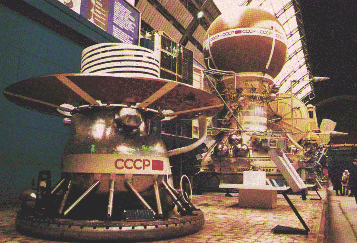|
|
Venera 13 & Venera 14

Venera 13 was launched on 30 October 1981 and Venera 14
was launched on 4 November 1981. They journeyed to Venus and deposited their
landers on 1 March and 5 March 1982, respectively. There were 2 high-energy
instruments aboard each spacecraft, one a continuation of the French-Soviet
collaboration and one called the "Konus" experiment. These
experiments returned data until March 1983.
Venera 13 and 14 contained the "Konus" experiments to observe
cosmic gamma-ray bursts. The instrument consisted of 6 scintillators with
angular sensitivities which were close to cosinusoidal. The detectors were
arranged along the positive and negative directions of the axes of the
satellite. The instrument was sensitive to 30 keV - 2 MeV. The maximum time
resolution was 1/256 s. Background was measured over the energy range 45-200
keV every 20 minutes. Every 4 hours, background was measured over the region
20 keV - 2 MeV. Eight seconds of preburst data were kept when a burst mode was
triggered, and recorded with 0.25 s resolution. The burst itself was measured
with a resolution of 1/256 s for 0.875 s, followed by a resolution of 1.64 s
for 12 s, and finally with a resolution of 1.4 s for 128 s. The spectra were
taken by Venera 13 in 16 channels over an integration time of either 0.5 s or
4 s. Venera 14 took spectra in 30 energy channels with the same 0.5 and 4 s
integration options.
There was also an updated version of the SNEG-2M3 (which was aboard Venera
11 & 12) experiment aboard Venera 13 & 14. The following features
remained the same: dimensions of detectors, temporal characteristics,
calibration energy scale, and nomogram SNEG-2M3. There were again 2 detectors
pointed in the solar/antisolar directions. The "burst" part of the
instrument changed. To trigger the burst mode, there had be a 6.5 sigma
increase in the count rate in less than 1 s, where sigma is the dispersion of
the averaged measured background. This increased the event analysis time by a
factor of 4, and the recording threshold was reduced 30%. Bursts wererecorded
over the energy range 50-800 keV. Improved photomultipliers allowed
measurements to be taken with a low energy threshold of 45-65 keV during the
first 10 months of operation.
The data from Venera 13 & 14 produced a confirmed gamma-ray burst event
of 1 every 3 days, a factor of 3 better than had been deduced previously from
Venera 11 & 12 and Prognoz 7. A total of 44, mostly confirmed, cosmic
gamma-ray events were detected between November 1981 and March 1982 by the 2
instruments.
[Gallery]
[Publications]
[All Missions]
[by Time]
[by Energy]
Page authors: Lorella Angelini Jesse Allen
HEASARC Home |
Observatories |
Archive |
Calibration |
Software |
Tools |
Students/Teachers/Public
Last modified: Thursday, 24-Sep-2020 17:37:05 EDT
|


